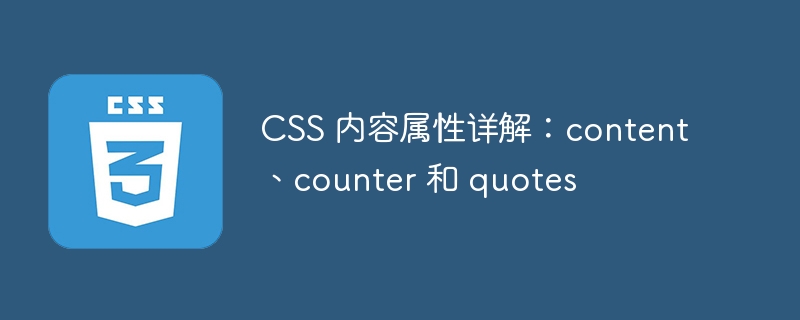

Detailed explanation of CSS content attributes: content, counter and quotes
CSS (cascading style sheets) is an indispensable part of front-end development, it can help us beautify web pages and enhance user experience. In CSS, there are some special properties that can be used to control the display of text content, including content, counter, and quotes. This article explains these properties in detail and provides specific code examples.
1. Content attribute
The content attribute can be used to insert additional content into text elements, which is especially common in pseudo-elements. The syntax is as follows:
::before { content: ""; }
Among them,::beforeis a pseudo-element selector, indicating that content is inserted before the content of the selected element.
The value of the content attribute can be a text string, a URL, a quote, or a counter. Let's introduce these possible values one by one.
Use double quotes or single quotes in content to insert the specified text string before the content of the selected element, for example:
::before { content: "提示:"; }
In this way, the prompt text "Prompt:" will be displayed before all elements using the::beforepseudo-element.
By using the URL, you can insert the specified image before the content of the selected element, for example:
::before { content: url("icon.png"); }
At this time, in An icon named "icon.png" will be displayed before all elements using the::beforepseudo-element.
When using quotation marks, you can insert the quotation mark before the content of the selected element, for example:
::before { content: open-quote; }
In this way, all using::beforeDouble quotes will be displayed before elements of pseudo elements.
Use a counter to display an automatically generated number or character before the content of the selected element, for example:
::before { content: counter(section-counter); counter-increment: section-counter; }
The above code will Displays an increasing number before all elements using the::beforepseudo-element.
2. Counter attribute
The counter attribute is used to define a counter to generate automatically incrementing numbers or characters. The syntax is as follows:
counter-reset: section-counter; counter-increment: section-counter;
The above code indicates that a counter named "section-counter" is created and initialized usingcounter-resetandcounter-incrementrespectively. and increment the counter value.
Among them,counter-resetis used to initialize the counter value, andcounter-incrementis used to increment the counter value.
3. Quotes attribute
The quotes attribute is used to define the style of quotation marks in text content. The syntax is as follows:
quotes: '“' '”';
The above code means to set the left quotation mark to """ and the closing quotation mark to """.
In HTML documents, we usually use double quotes or single quotes to indicate the beginning and end of quotes. When using thequotesattribute, we can customize the style of quotation marks.
4. Code Example
Now, let’s look at a complete example using the content, counter and quotes attributes:
Title
Lorem ipsum dolor sit amet, consectetur adipiscing elit.
Phasellus ac arcu sed ex gravida hendrerit. Duis euismod massa est, ac faucibus magna rhoncus et.
Vestibulum lobortis enim et turpis ultrices, vitae venenatis odio tincidunt.
Quisque vestibulum faucibus velit, at egestas leo efficitur ut.
In the above example, we used::beforepseudo-element to insert an automatically generated number before eachpelement and use a custom quote style.
Through the above code examples, we can see how to flexibly use the content, counter and quotes attributes to control the display of text content on the page.
Summary:
By learning and mastering the content, counter and quotes attributes, we can manipulate text content more flexibly in CSS. The content attribute can be used to insert text strings or other elements; the counter attribute is used to create a counter and generate an automatically incrementing value; the quotes attribute is used to define the style of quotation marks in the text. The application of these attributes allows us to better control the presentation of content and improve the user experience of web pages.
The above is the detailed content of CSS content properties explained: content, counter, and quotes. For more information, please follow other related articles on the PHP Chinese website!
{{$t('Counter: {n}',{n:counte...




